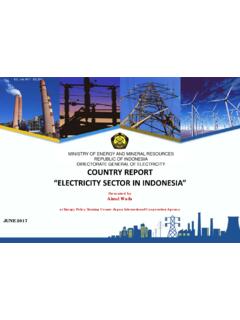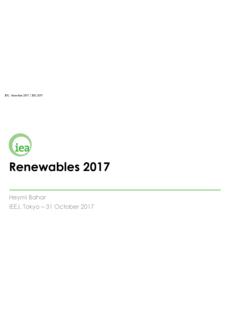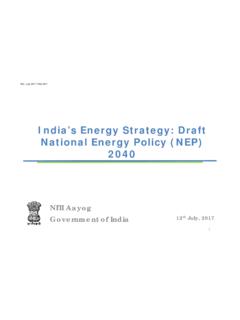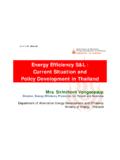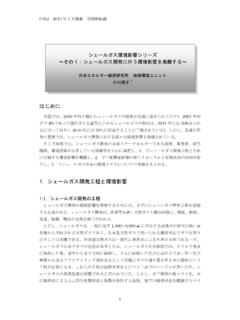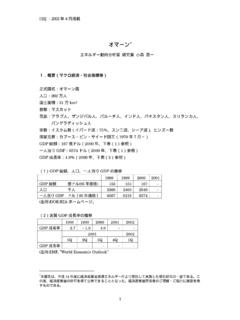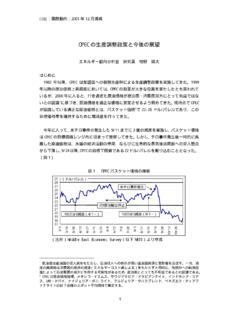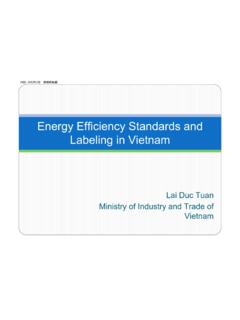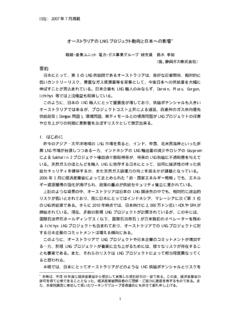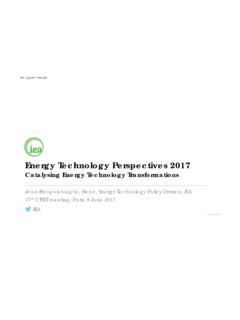Transcription of Energy Intensity of GDP as an Index of Energy …
1 IEEJ: August 2007 1 Energy Intensity of gdp as an Index of Energy Conservation Problems in international comparison of Energy Intensity of gdp and estimate using sector-based approach Shigeru Suehiro* Introduction Internationally, we are more interested in Energy conservation. Behind this background are soaring Energy prices and global warming. Japan is said to be the most advanced country with regard to Energy conservation, and its Energy -reduction technology is highly evaluated. The most eminent example of this is the Energy Intensity of gdp (gross domestic product) or Energy consumption per GDP. Energy Intensity of gdp is easy to calculate and is often used as an Energy -conservation Index for a country. Comparing Energy Intensity internationally, you will know while that of the is times as large as that of Japan, that of China and India, where Energy demand is increasing, is times and times larger, respectively, highlighting their large potential for Energy conservation.
2 However, if you calculate it by GDP converted to purchasing power parity, China s Energy Intensity is reduced to times as large as that of Japan, and that of India is times as large as that of Japan, showing that India is a better Energy -saving country than Japan. Even though the results of an evaluation based on Energy Intensity of gdp vary, largely depending on the currency conversion rate used, there is no international consensus for a calculation method. However, it is inconvenient to leave such gaps unchanged for future Energy -conservation analysis and policies, and they had better be resolved. This paper first sorts the concept of Energy Intensity of gdp and then points out problems with the estimate. It also suggests an estimate using a sector-based approach taking these problems into consideration and performs a new calculation of Energy Intensity .
3 1. What is Energy Intensity of gdp ? Energy conservation means decreasing the quantity of Energy used without changing the amount of work gained (production, temperature, brightness, distance and so on). In other words, it means increasing the amount of work without changing the quantity of Energy used. As a measurement of Energy conservation, Energy Intensity , which is the amount of Energy consumption per work unit, is often used. Although the term Energy conservation often is used in relation to technological Energy efficiency, there also is Energy conservation based on consumer Energy -saving behavior, or changes in industrial structure and in lifestyle, and there are needs for measuring entire Energy conservation of a country, * Senior Economist at the Institute of Energy Economics, Japan (working for Energy Demand, Supply and Forecast Analysis Group, Energy Data and Modelling Center as well as Energy Conservation Group, Strategy and Industry Research Unit) IEEJ: August 2007 2including all such technological, structural, and behavioral factors.
4 This is what Energy Intensity of gdp is for. Now, why is GDP used here? It s not preferred to treat GDP, which shows the amount of money and Energy as a physical quantity in the same measure. However, it is difficult to show the amount of work of the whole country as a physical quantity. GDP is a popular Index reflecting a country s economy and is easy to obtain because many countries estimate it. This is probably the reason GDP is often used. Then, how should we interpret the amount of work gained by using Energy quantity? One way is to regard it as the amount of production. GDP is a country s total value of production, and in economics, the amount of labor or capital is often used as the necessary input factor for production. GDP per labor unit (working person or working hour) is called labor productivity. Similarly, Energy is considered an input factor for production, and this is the concept of Energy productivity (and its reciprocal number is Energy Intensity ).
5 1 That is to say, the idea of Energy efficiency and Energy Intensity of gdp show how efficiently you can increase production from the viewpoint of Energy . Another interpretation is the concept of utility. Through machinery, such as TVs and air conditioners, we gain utility (or comfort and convenience), such as information or warmth/coolness. In other words, we can say we consume Energy in order to enhance utility. Therefore, the total amount of utility gained from machinery in a country would represent the country s living standard. Because it is difficult to quantify the living standard, the level of income is often used as a substitute. When comparing wealth among countries, average income per capita often serves as the Index . GDP is a country s total value of production as well as its total value of Given this perspective, Energy Intensity of gdp can be something that illustrates how efficiently the living standard can be enhanced from the viewpoint of Energy .
6 As seen above, Energy Intensity of gdp can be said to contain the two concepts of Energy efficiency on the production system and Energy efficiency on lifestyle. However, their directional characters are not necessarily the same. Manufacturing productivity in economically developing countries is generally inefficient while their living standard is lower and Energy consumption is smaller. In other words, they have Energy -intensive production systems and a non- Energy -intensive lifestyle (different from Energy conservation) at the same time. Meanwhile, economically mature countries have high 1 However, because Energy is an intermediate input factor, some people point out that it cannot be dealt with as an input factor in parallel with labor or capital. GDP is the amount of added value and Energy cannot be considered as an input factor when added value is allocated to the input factors.
7 2 GDP s Principle of Equivalent of Three Aspects. Production (supply), distribution (income) and expenditure (demand) are equal. IEEJ: August 2007 3manufacturing productivity but the convenient lifestyle results from the possession of many electrical appliances and automobiles. In other words, they simultaneously have non- Energy -intensive production systems and a Energy -intensive lifestyle based on large-scale Energy consumption. In short, there is a tendency for Energy efficiency of the production system to increase and that of the lifestyle to decrease as the economy develops. When comparing Energy Intensity of gdp internationally, you need to pay attention to the level of economic development as stated above. Even if a country is small in Energy Intensity , it does not necessarily mean that the country is advanced in Energy conservation; it can mean that they only have a non- Energy -intensive lifestyle because of the low level of living.
8 In addition, you need to take natural conditions and geographical conditions into consideration as well. For example, people need heating in cold areas in order to maintain life even if the standard of living is low. Also, efficiency tends to decrease in countries with a wide land area because of the diffused population. Because Energy Intensity of gdp is estimated by abstracting such various conditions, you need to be careful when handling the data. 2. Problems in the estimate of Energy Intensity of gdp When estimating Energy Intensity of gdp in order to conduct country-by-country comparison, you need to be careful about GDP conversion, which is a denominator of Energy Intensity . The Organization for Economic Co-operation and Development (OECD) points out that there are four necessary conditions when numerically comparing GDP among countries: (1) the definition of gdp must be the same, (2) measuring methodologies must be the same, (3) the currency units used must be the same, and (4) the evaluated levels of prices must be the same.
9 Basically, there are no problems regarding the 1st and 2nd conditions because GDP is calculated in accordance with the System of National Accounts (SNA)3 proposed by the , except data from developing countries and other countries where statistics are not well The 3rd condition shows that, because GDP generally is calculated in each country s currency, currency units have to be converted to one unit. dollars are often used. The 4th condition indicates that the currency conversion rate has to be set so that each currency is equivalent in terms of quality and quantity of goods/services it can buy ( when one dollar is valued at 100 yen, the quality and quantity of goods/services it can buy with one dollar has to be the same as what 100 yen can buy). In short, the 3rd and 4th conditions require the use of a proper currency exchange rate. In 3 Currently, 93 SNA which member states were advised to introduce in 1993 is the standard.
10 4 There seems to be confusion in accordance with transition from Material Product System (MPS) to SNA in ex-socialist countries. IEEJ: August 2007 4the real world, the market exchange rate(MER) is used when exchanging a country s currency for another currency. It is also often used when converting GDP to dollars. Another rate to translate the currency of a country into a common unit is purchasing power parities (PPP), which is a currency exchange rate taking each country s level of prices into consideration5 and estimated by OECD and the World Bank. Figure 1 shows primary Energy Intensity of gdp calculated using MERs (Japan = 1). Japan s Energy Intensity is one of the best in the world,6 that of European advanced countries is to times as large as that of Japan, and that of developing countries is 2 to 40 times as large as that of Japan, showing large differences among countries.
